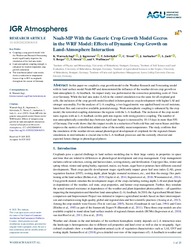Noah‐MP With the Generic Crop Growth Model Gecros in the WRF Model: Effects of Dynamic Crop Growth on Land‐Atmosphere Interaction
DOI: https://doi.org/10.1029/2022JD036518
Persistent URL: http://resolver.sub.uni-goettingen.de/purl?gldocs-11858/10273
Persistent URL: http://resolver.sub.uni-goettingen.de/purl?gldocs-11858/10273
Supplement: https://opendata.dwd.de/climate_environment/CDC/grids_germany/daily/Project_TRY/air_temperature_mean/, https://doi.org/10.5281/zenodo.6501984, http://land.copernicus.eu/pan-european/corine-land-cover/clc-2006/view, https://doi.org/10.1594/WDCC/WRF_NOAH_HWSD_world_TOP_SOILTYP
Warrach‐Sagi, K.; Ingwersen, J.; Schwitalla, T.; Troost, C.; Aurbacher, J.; Jach, L.; Berger, T.; Streck, T.; Wulfmeyer, V., 2022: Noah‐MP With the Generic Crop Growth Model Gecros in the WRF Model: Effects of Dynamic Crop Growth on Land‐Atmosphere Interaction. In: Journal of Geophysical Research: Atmospheres, Band 127, 14, DOI: 10.1029/2022JD036518.
 |
Dokument öffnen: |
In this paper we coupled a crop growth model to the Weather Research and Forecasting model with its land surface model Noah‐MP and demonstrated the influence of the weather driven crop growth on land‐atmosphere (L‐A) feedback. An impact study was performed at the convection permitting scale of 3 km over Germany. While the leaf area index (LAI) in the control simulation was the same for all cropland grid cells, the inclusion of the crop growth model resulted in heterogeneous crop development with higher LAI and stronger seasonality. For the analyses of L‐A coupling, a two‐legged metric was applied based on soil moisture, latent heat flux and convective available potential energy. Weak atmospheric coupling is enhanced by the crop model, the terrestrial coupling determines the regions with the L‐A feedback. The inclusion of the crop model turns regions with no L‐A feedback on this path into regions with strong positive coupling. The number of non‐atmospherically controlled days between April and August is increased by 10–15 days in more than 50% of Germany. Our work shows that this impact results in a reduction of both cold bias and warm biases and thus improves the metrics of distributed added value of the monthly mean temperatures. The study confirms that the simulation of the weather driven annual phenological development of croplands for the regional climate simulations in mid‐latitudes is crucial due to the L‐A feedback processes and the currently observed and expected future change in phenological phases. Key Points:
Coupling a crop growth model with the Weather and Research Forecasting model significantly improves the simulation of the leaf area index.
Land‐atmosphere coupling strength is enhanced by weather dependent crop growth simulation.
The distributed added value metric shows a reduction in temperature biases of up to 80% in croplands throughout the season in Germany.
Statistik:
ZugriffsstatistikSammlung:
Schlagworte:
regional climate model coupled with dynamic crop modelWRF
land‐atmosphere feedback
Noah‐MP
two‐legged coupling index
land‐atmosphere‐feedback metrics
This is an open access article under the terms of the Creative Commons Attribution‐NonCommercial‐NoDerivs License, which permits use and distribution in any medium, provided the original work is properly cited, the use is non‐commercial and no modifications or adaptations are made.

